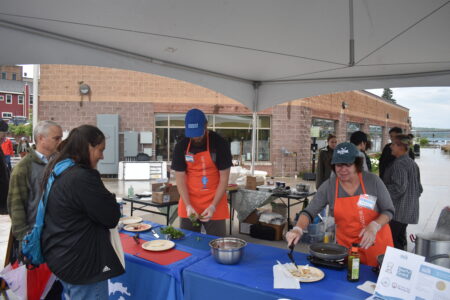Greeting the goats
Part of invasive species removal effort

Paula Porter, for the Gazette A group of youngsters "greet the goats" at the event with the same name Saturday at the Swedetown trails. For the third year, dozens of goats. have been brought in from Wisconsin as part of en effort to eradicate glossy buckthorn, an invasive plant.
SWEDETOWN — The popular Greetings to the Goats event was held Saturday at the Swedetown trails. A good crowd showed up on the warm comfortable day. Visitors to the event saw goats running and eating along the Swedetown trail behind a fence. The event was held from 11 a.m. to 1 p.m. right on the trail in Swedetown.
For many, greeting a goat is not an everyday occurrence, especially here in the Copper Country. These goats are part of an initiative to eradicate an invasive plant — the glossy buckthorn. It is an unwelcome plant so the objective of the program is to remove it the best way they can.
The event, in its third year, was not only a chance to see the goats up close and personal but to learn exactly what they were doing on the Swedetown trail. There is a total of 60 goats this year, down from last year’s total of about 70, but up from the 30 to 40 goats that came up the first year. A few of this years group were kids born this spring.
The Glossy Buckthorn is an invasive plant to our local area. It is not beneficial to have here and spreads if not removed. Michigan Technological University’s College of Forest Resources and Environmental Science (CFRES) is working towards eliminating the Buckthorn through an Upper Peninsula Environmental Coalition (UPEC) grant they were awarded to fund the goats program. The goats are rented from a goat browser contractor, Regenerative Ruminants from Wisconsin. It seems these goats eat practically anything, especially our glossy buckthorn.
August Camp of Tech’s CFRES is with Keweenaw Invasive Species Management Area, (KISMA) and was on hand to run the event Saturday. Camp works with Sigrid Resh at MTU on Glossy Buckthorn research. Tech is studying the efficacy of goat browsing as bio-control for the glossy buckthorn on a larger scale. The study is collecting data and doing vegetation monitoring on plots.
Camp, said “Glossy buckthorn diminishes the ecosystem health and diversity by out-competing native shrubs and reducing available food sources for native insects and birds.” His group studies the plant throughout the Keweenaw.
According to Camp, it’s obvious to see the goats have had a significant impact on the trail so far. “It’s night and day”, said Camp. Even though the ruminants are making progress toward the removal goals, it’s not a one and done thing. And hopefully the goats will be back next year.
Camp also invites volunteers to join them every Friday at the Swedetown chalet for the program Healthy forests, Healthy Communities. “It’s our volunteer hand removal efforts to remove Buckthorn. Bring a friend or bring your family along. Be part of the solution. It protects the birds, the insects, and all of us.” Camp said the group meets from 1 – 3:30m p.m. at the Swedetown Chalet.
One young attendee who visited with her family to see the goats at the trails, said, ” I like goats. They’re cool. They’re nice.”






